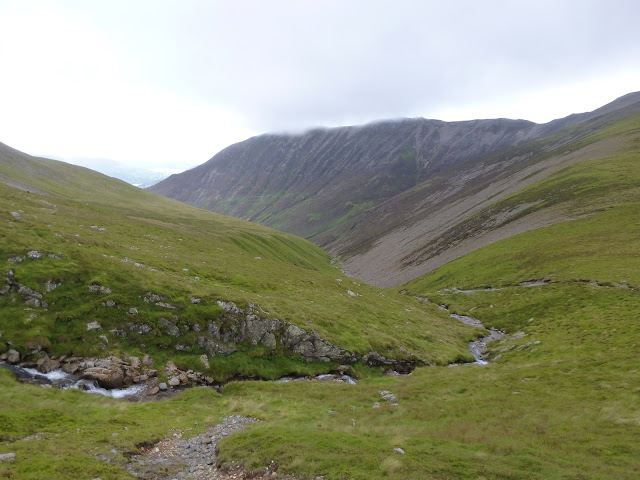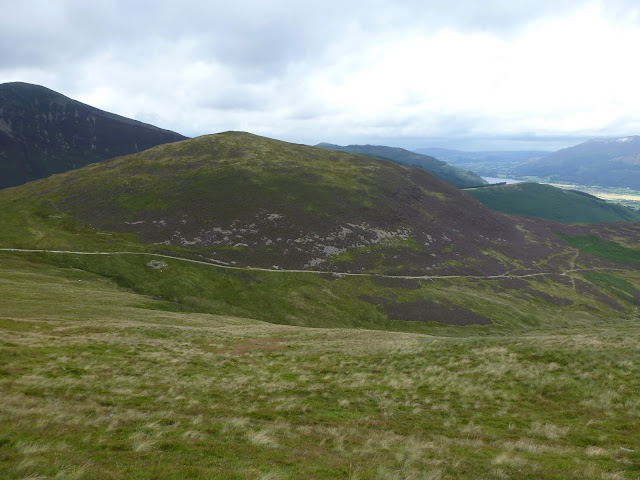This map was created using GPS Visualizer's do-it-yourself geographic utilities.
Please wait while the map data loads...
From: Braithwaite
Parking: Car Park at foot of Whinlatter Pass
Start Point: Car Park at foot of Whinlatter Pass
Region: North Western Fells
Route length: 13.5 miles (21.7km)
Time taken: 06:10
Average speed: 2.2mph
Ascent: 1,659m
Descent: 1,666m
Wainwrights on this walk:
Grisedale Pike (731m), Hopegill Head (770m), Grasmoor (852m), Wandope (772m), Crag Hill (839m), Sail (773m), Scar Crags (672m), Causey Pike (637m), Outerside (568m), Barrow (455m)
Additional summits: Kinn (374m), Hobcarton Crag (739m), Sand Hill (756m)
Other points of interest: Force Crag, Hobcarton Crag, Eel Crag
My first visit to the northwestern fells, the compact region of fells to the west of Keswick. A free weekend and a new set of GPS waypoints quickly identified Coledale as an area rich in scenery, excitement, steep crags and, most importantly, several peaks to visit. Perhaps not as smooth a horseshoe as Fairfield or Kentmere, the Coledale round still manages to cross seven Wainwrights including the mighty Grasmoor. The walk we did included two more, nestling on a secondary ridge below Causey Pike. Wainwright was certainly correct by stating that 'nothing goes to waste' in this small area of the District.
It was to be a difficult day weather-wise as the forecast was for wandering showers throughout the day and variable wind speeds. Indeed, as we set off from the small car park, off the Whinlatter Pass, it started raining, so it was on with the waterproofs which remained in-situ for most of the day.
 |
| A heavy shower gives Keswick a good dousing |
 |
| Kinn, the ridge leading to Grisedale Pike |
 |
| The path up Sleet How onto Grisedale Pike |
 |
| A heavy spell of rain made the going a bit more challenging, lubricating the slate beneath our feet |
 |
| The summit of Grisedale Pike |
 |
| The path disappears into the clouds as it continues towards Hopegill Head |
 |
| Hobcarton Crag forms the northeastern face of Hopegill Head |
 |
| The summit was just visible in the clouds |
 |
| No views from the summit of Hopegill Head |
 |
| Crag Hill and Coledale Hause await as we descend Sand Hill |
 |
| The clouds lift momentarily and we caught a glimpse of the craggy Whiteside |
 |
| Climbing back into the clouds to reach the summit of Grasmoor |
 |
| The sprawling cairn/shelter at the summit |
 |
| The unassuming Wandope from Grasmoor |
 |
| Crag Hill and Sail from Wandope |
 |
| The cairn on the summit of Wandope |
 |
| The northwestern fells in all their glory |
 |
| The traverse around the shoulder of Crag Hill |
 |
| Wandope |
 |
| The triangulation pillar marking the summit of Crag Hill as the clouds begin to lift |
 |
| From Crag Hill the path descends to 'The Scar' and then up Sail |
 |
| The Scar provides a great view of Scott Crag, Hopegill Head and Grisedale Pike |
 |
| The cairn on the summit of Sail |
 |
| The raised path that snakes down the eastern side of Sail and back up Scar Crags at the far end |
 |
| The steep drop from Scar Crags into Rigg Beck |
 |
| The summit of Scar Crags looking towards Causey Pike |
 |
| The four humps that make up Causey Pike |
 |
| Scar Crags from Causey Pike |
 |
| The panorama from Causey Pike |
 |
| The rocky summit of Causey Pike |
 |
| Outerside as seen from the ridge to Causey Pike |
 |
| Grisedale Pike from Outerside |
 |
| The summit of Outerside |
 |
| Skiddaw momentarily appears out of the clouds |
 |
| Barrow presents the final obstacle of the day |
 |
| Causey Pike catches the afternoon sunlight |
 |
| The summit of Barrow |
 |
| The descent is nice and steady down into Braithwaite |
Despite the disappointment of not seeing Hopegill Head or the views from Grasmoor, the final half of the walk more than made up for it. The views are simply staggering, thanks to the steep-sided nature of the northwestern fells. The Coledale round was certainly a great way to kick off my exploration of this area of the Lakes and I'll definitely be back to investigate this area more thoroughly.

No comments :
Post a Comment